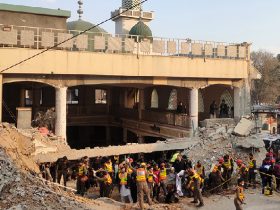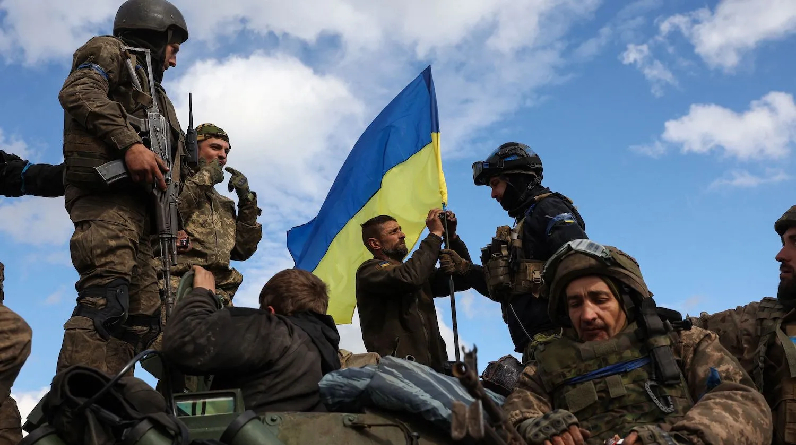Russia has deployed around 300,000 additional troops to the Ukraine front after beginning to call up reservists and conscripts in the fall of 2022. More and more highly trained mercenary soldiers from the private Wagner Group have joined these so-called mobiks. The combined efforts of the new recruits and the existing forces have allowed the invaders to secure their positions for the remainder of the winter. Could Russia finally be able to break through Ukraine’s stalwart defence this spring, when a new offensive seems imminent?
Both numerically and strategically, Russia is about where it was a year ago. Since beginning the invasion in February 2022, it has made some progress. However, these advancements are far short of the apparent initial war goals. And they have not been free at all: Over the past year, the U.S. military estimates that Russia has suffered over 100,000 casualties (dead, wounded, captured, and missing). These numbers, according to Ukrainian sources, significantly understate Russia’s actual losses. It is estimated that the defenders suffered an equal amount, with many more civilian deaths and widespread national destruction. Russia has not achieved much thus far, but it seems determined to keep pushing forward regardless.
Anticipating the Upcoming Conflict
Winter has been a time of reinforcement, replenishment, and reevaluation for both Russia and Ukraine. Russian forces have established a land link to President Vladimir Putin’s 2014 Crimean conquest, which began in the south. The Russians had advanced to the right bank of the Dnieper River, but Ukrainian counterattacks had driven them back. Wagner’s professional forces have launched a serious offensive in the center-north, near the towns of Soledar and Bakhmut, and the fighting has been intense throughout the winter. Wagner forces, however, are only a stopgap and cannot mount decisive, war-winning operations on a large scale.
President Volodymyr Zelenskyy of Ukraine has been aggressively lobbying the West to supply Ukraine with cutting-edge weaponry. Ukraine’s air-defense network for countering fighter-bomber and missile strikes has received less attention than recent allocations of main battle tanks and other armoured vehicles. Air defence cannot win a war, but its absence can lose one rather quickly, as recently stated by Thomas Karako of the Center for Strategic and International Studies.
According to a November 2022 report by the Royal United Services Institute in the United Kingdom, written by Justin Bronk, who echoes these sentiments, NATO air-defense systems and missiles are essentially the only thing keeping the Russian air force away from the front lines. He expressed concern that Ukraine could lose the war if its air defence system failed.
Ukraine’s main priority at the moment is to stay alive in the conflict. Russia’s initial approach in Ukraine was fruitless, but it has since refocused and achieved some success, albeit at a high price. Still, Putin can’t keep this up indefinitely, and the upcoming election season could make or break one side. Also, the war could drag on for a while longer.
It’s safe to assume that the Russian forces at their disposal this coming spring will be smaller in number but no less ineffectual than the ones that attacked Ukraine a year ago. There appears to be enough reinforcements to make up for all of the losses sustained over the past year of fighting. According to the requirements, they have received military specialty training that is sufficient. The mobiks are used to replace unused storage space. Attacking, however, is where such advantages really shine, and that calls for a lot of practise and top-notch leadership.
In Russia, thousands of its frontline officers and noncommissioned officers have been killed or wounded. Leadership of this calibre cannot be quickly assembled and groomed. There are many ways to train officers, but nothing beats years of actual experience leading troops, even in simulated situations. Most civilian college graduates would find it impossible to master the wide range of military disciplines and specialties that officers are expected to know inside and out. Furthermore, leaders on the battlefield need to have a leadership mindset, which is the single most challenging quality to instill in a person. Leaders, not managers, are needed to oversee the military, and developing effective commanders is more art than science.
At the same time, it can be difficult to replace expensive machinery that has been destroyed. Tanks, infantry fighting vehicles, artillery pieces, multiple rocket launchers, air defence systems, trucks, and more were all stashed away in Russia in massive quantities. However, it was discovered that much of the stored equipment is in a deteriorated state, lacking in many necessary parts, and the rest is broken and unusable. Some vehicles and equipment were routinely stolen and sold for scrap, while others were cannibalised to repair front-line machinery. Corruption at such a high level is widely reported to be pervasive in the Russian armed forces.
Russia has responded by setting up two new factories to repair weapons, one in the Moscow area and another in the Rostov region. Both locations take damaged pieces of machinery from the field and reassemble them into newer pieces for use in either storage or the field. By doing so, relatively effective weaponry can be produced to make up for the heavy material losses that have already occurred. Russia held the line all summer long using equipment that should have been retired decades ago but was instead brought back into service.
Russia’s biggest problem is replacing the high-tech precision weapons and cutting-edge machinery it’s used up. Russia is unable to manufacture microprocessors or many other types of electro-optical devices. It also lacks the precision-machining capabilities of Western countries because so few of its machines are computer-controlled. They are no longer able to receive maintenance and calibration, and they have been denied access to some cutting-edge equipment. As a result, Russia struggles to produce essential precision equipment like aircraft engine parts.
Ukraine’s Hand Strengthens
Ukraine, meanwhile, has been replacing losses with newly trained mobilised personnel and equipment received from allied countries in a steady stream. The latter has been proven to be vastly superior to hardware imported from Russia. Many of Ukraine’s replacement soldiers have been trained by allies in the West’s extensive training facilities, where they have received not only basic but also advanced familiarisation with Western weapon systems. The use of cutting-edge networked command and control systems is a key component of the training, which will greatly improve the effectiveness of Ukrainian forces in combat. Since there is nothing analogous on the Russian side, the Ukrainian military can more effectively counter a superior foe despite being smaller and more nimble.
See Also: 5 Of The Best New Watches Released In 2023
There will be enough armour to outfit five brigades in Ukraine thanks to the recent promises. The Ukrainian armed forces have been able to replace their losses thanks to the delivery of ex-Soviet equipment from former Warsaw Pact nations now in NATO. This has included the delivery of tanks and infantry-fighting vehicle types that are moderately outdated but well-serviced.
On paper, Ukrainian forces appear to be in a stronger position to counter the renewed offensive than they were in February 2022, while Russia struggles to restore its military to its pre-invasion strength. Ukraine’s ability to produce armaments and even basic ammunition is low, so the country relies heavily on military aid from other countries. It relies heavily on Western high-tech weapons, missiles, and especially air-defense systems, as we’ve already established.
















Leave a Reply